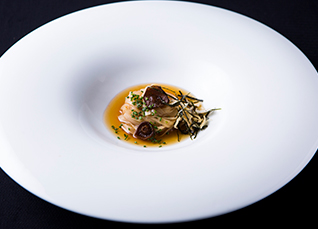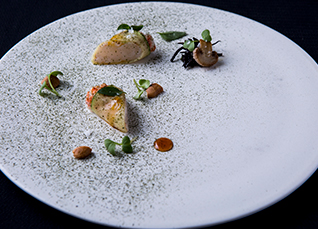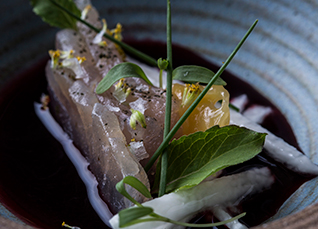






The tasting menu is the best way to get acquainted with the gastronomic experience proposed by D.O.M., which is hard to be captured with one single dish. Alex Atala presents a strictly authorial menu, exposing his boldness and his experimentations, result of his researches with Brazilian ingredients.



Explore the ingredients by clicking on the spots.
 North Region - Tucupi
North Region - TucupiA yellowish liquid extracted from a kind of pressed wild manioc. Considered poisonous, it must be boiled for at least 20 minutes to evaporate the cyanide in the roots. Typical of the Amazon region, it is used to season fishes and fowls, especially ducks.
 North Region - Priprioca
North Region - Priprioca
A root found in the Amazon region, used only previously by the cosmetic industry, from which chef Alex Atala developed an edible essence.
 North Region - Jambu
North Region - Jambu
The jambu, or Pará Cress (Splilanthes oleracea) is a local herb from the Amazon region, known for its capacity to deliver an electrical sensation through the body when chewed.
 North Region - Pupunha Heart of Palm
North Region - Pupunha Heart of Palm
The pupunha is a kind of cultivated heart of palm, contrasting with the native species (such as juçara), which are under threat of extinction due to the uncontrolled exploitation. Chef Alex Atala only uses in his kitchen pupunha heart of palm from sustainable sources.
 North Region - Beldroega
North Region - Beldroega
The beldroega (Portulaca oleracea), found in the North and Northeast regions of Brazil, is considered a refreshing plant with medical properties, because of its minerals and vitamins, and its great quantities of salicylic acid.
 North Region - Peixe Filhote
North Region - Peixe Filhote
A teleost fish. Dark with a large head and small eyes, it can weight up to 300 kg and be about 2m wide, through the specimen caught nowadays weight under 10 kg. Individuals under 60 kg are called filhote (Portuguese for pup).
 Central West region - Baru
Central West region - Baru
Its taste similar to the peanut and cashew nuts, but it is considered more dominant, as if the nut had been more toasted. It´s rich in proteins, fibers and minerals, and also fatty acids such as omega-6 and omega-9.
 Southeast region - Canjiquinha
Southeast region - Canjiquinha
Also known as white corn, it is a variety of the vegetable well known in Brazil, especially for the production of sweets (such as canjica or munguazá) and as side dish to meats and stews.
 Northeast region - Tapioca
Northeast region - Tapioca
A by-production of the peeled, minced and drained manioc, for the production of granulose flour. Omnipresent in Brazilian culture, tapioca is the basis of many dishes, such as puddings, cakes, porridges and the beiju, a native specialty.

